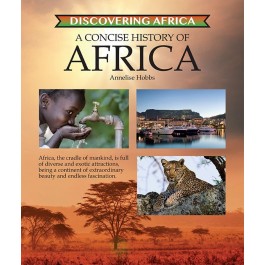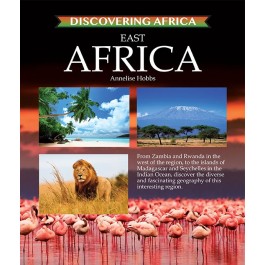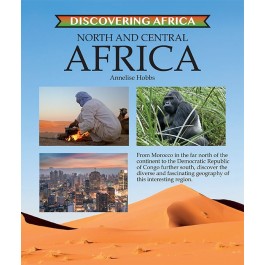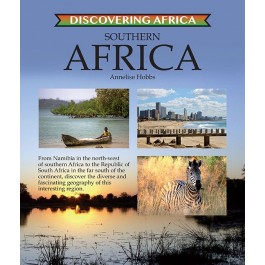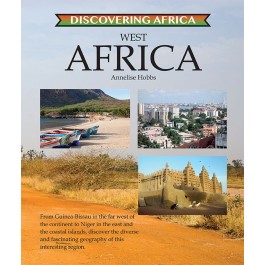DISCOVERING AFRICA
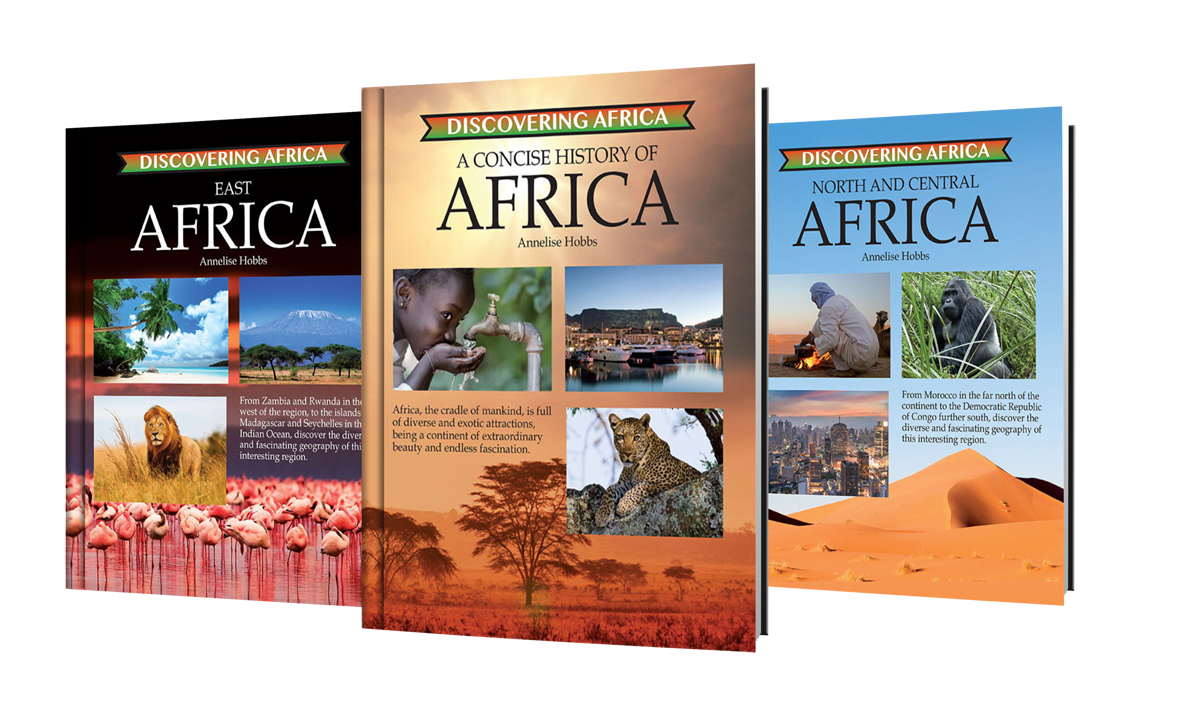
5
2017
12+
7th - 12th
8 x 9.5
Booklist Review
Highlighting the rich diversity of Africa’s eastern nations, comes this volume in the Discovering Africa series. From Ethiopia, Kenya, and Somalia to possibly lesser-known Burundi, Mauritius, and Seychelles, the book offers encyclopedia-like articles on 13 countries as well as a combined article on the Comoros Islands and Mayotte, an insular department and region of France. Each article introduces such facts as the country’s geography, history, population, political system, economy, climate, natural resources, and flora and fauna. Border disputes and battles for independence are also addressed. What enlivens the straightforward text are the gorgeous color photographs that focus on the wide variety of and sometimes surprising landscape and wildlife throughout East Africa. This volume is a useful source for older students researching countries and looking at the entire area in context.by Annelise Hobbs
| Hardcover | ISBN 978-1-4222-3716-8 | $24.95 | Add To Cart |
| eBook | ISBN 978-1-4222-8067-6 | $31.95 | Add To Cart |
Africa, the cradle of mankind, is a continent of extraordinary beauty and endless fascination. Africa’s history has seen the rise and fall of empires and kingdoms. It has experienced the power of religion and the injustice of slavery. It has endured the struggle against colonialism and the celebration of independence. Modern Africa has enormous manpower and resources at its disposal, and is modernizing at a rapid rate, so fast that the next few decades will see great benefits to the continent as a whole and its population.
Each title in this series includes a map of the countries in each volume, color photos throughout, and back matter including: an index and further reading lists for books and internet resources. Key Icons appear throughout the books in this series in an effort to encourage library readers to build knowledge, gain awareness, explore possibilities and expand their viewpoints through our content rich non-fiction books. Key Icons in this series are as follows: Words
to Understand are shown at the front of each chapter with definitions. These words are set in boldfaced type in that chapter, so that readers are able to reference back to the definitions--building their vocabulary and enhancing their reading comprehension. Sidebars are highlighted graphics with content rich material within that allows readers to build knowledge and broaden their perspectives by weaving together additional information to provide realistic and holistic perspectives. Text-Dependent Questions are placed at the end of each chapter. They challenge the reader’s comprehension of the chapter they have just read, while sending the reader back to the text for more careful attention to the evidence presented there.
by Annelise Hobbs
| Hardcover | ISBN 978-1-4222-3717-5 | $24.95 | Add To Cart |
| eBook | ISBN 978-1-4222-8068-3 | $31.95 | Add To Cart |
East Africa is a large area spanning the most easterly region of the African continent. Countries of this region include Burundi, Comoros and Mayotte, Djibouti, Kenya, Eritrea, Ethiopia, Madagascar, Mauritius, Somalia, Réunion, Rwanda, Seychelles, Tanzania, and Uganda. Renowned for its concentrations of wild animals, beautiful landscapes, exceptional ancient history, and diverse culture, it is also widely understood among most archaeologists, that East Africa is where modern humans first appeared. This book provides the reader with a fascinating insight into the region of East Africa country-by-country, examining the customs, history, geography, and natural world.
Each title in this series includes a map of the countries in each volume, color photos throughout, and back matter including: an index and further reading lists for books and internet resources. Key Icons appear throughout the books in this series in an effort to encourage library readers to build knowledge, gain awareness,
explore possibilities and expand their viewpoints through our content rich non-fiction books. Key Icons in this series are as follows: Words to Understand are shown at the front of each chapter with definitions. These words are set in boldfaced type in that chapter, so that readers are able to reference back to the definitions--building their vocabulary and enhancing their reading comprehension. Sidebars are highlighted graphics with content rich material within that allows readers to build knowledge and broaden their perspectives by weaving together additional information to provide realistic and holistic perspectives. Text-Dependent Questions are placed at the end of each chapter. They challenge the reader’s comprehension of the chapter they have just read, while sending the reader back to the text for more careful attention to the evidence presented there.
by Annelise Hobbs
| Hardcover | ISBN 978-1-4222-3718-2 | $24.95 | Add To Cart |
| eBook | ISBN 978-1-4222-8069-0 | $31.95 | Add To Cart |
The vast areas of North and Central Africa include the contrasting countries of Algeria, Egypt, Libya, Tunisia, Morocco, and Western Sahara in the north of the continent, to Chad, Central African Republic, Democratic Republic of Congo, Equatorial Guinea, Gabon, São Tomé and Príncipe, Republic of Congo, South Sudan, and Sudan in Africa’s central zone. All the countries examined here, while very different in their physical nature, are blessed with strikingly beautiful landscapes, wonderous architecture, and intriguing cultures. This book provides the reader with a fascinating insight into the regions of North and Central Africa, country-by-country, examining the customs, history, politics, geography, and natural world.
Each title in this series includes a map of the countries in each volume, color photos throughout, and back matter including: an index and further reading lists for books and internet resources. Key Icons appear throughout the books in this series in an effort to
encourage library readers to build knowledge, gain awareness, explore possibilities and expand their viewpoints through our content rich non-fiction books. Key Icons in this series are as follows: Words to Understand are shown at the front of each chapter with definitions. These words are set in boldfaced type in that chapter, so that readers are able to reference back to the definitions--building their vocabulary and enhancing their reading comprehension. Sidebars are highlighted graphics with content rich material within that allows readers to build knowledge and broaden their perspectives by weaving together additional information to provide realistic and holistic perspectives. Text-Dependent Questions are placed at the end of each chapter. They challenge the reader’s comprehension of the chapter they have just read, while sending the reader back to the text for more careful attention to the evidence presented there.
by Annelise Hobbs
| Hardcover | ISBN 978-1-4222-3719-9 | $24.95 | Add To Cart |
| eBook | ISBN 978-1-4222-8070-6 | $31.95 | Add To Cart |
Countries of the southernmost region of the African continent include Angola, Botswana, Lesotho, Malawi, Mozambique, Namibia, South Africa, Swaziland, Zambia, and Zimbabwe. The terrain of Southern Africa is varied, ranging from forests to deserts to grasslands. It is an area rich in natural resources and therefore the region has become an important exporter in platinum, diamonds, gold, and uranium. It is home to many cultures and ethnic groups and also, following the process of colonization has significant populations of Europeans. This book provides the reader with a fascinating insight into the region of Southern Africa country-by-country, examining the customs, history, geography, and natural world. Each title in this series includes a map of the countries in each volume, color photos throughout, and back matter including: an index and further reading lists for books and internet resources. Key Icons appear throughout the books in this series in an effort to encourage library
readers to build knowledge, gain awareness, explore possibilities and expand their viewpoints through our content rich non-fiction books. Key Icons in this series are as follows: Words to Understand are shown at the front of each chapter with definitions. These words are set in boldfaced type in that chapter, so that readers are able to reference back to the definitions--building their vocabulary and enhancing their reading comprehension. Sidebars are highlighted graphics with content rich material within that allows readers to build knowledge and broaden their perspectives by weaving together additional information to provide realistic and holistic perspectives. Text-Dependent Questions are placed at the end of each chapter. They challenge the reader’s comprehension of the chapter they have just read, while sending the reader back to the text for more careful attention to the evidence presented there.
by Annelise Hobbs
| Hardcover | ISBN 978-1-4222-3720-5 | $24.95 | Add To Cart |
| eBook | ISBN 978-1-4222-8071-3 | $31.95 | Add To Cart |
The subcontinent of West Africa is a vast area of land which includes the countries of Benin, Burkina Faso, Cameroon, Cape Verde, Côte d’Ivoire, Gambia, Ghana, Guinea, Guinea-Bissau, Liberia, Mali, Mauritania, Niger, Nigeria, Senegal, Sierra Leone, and Togo. The region is bordered by the Atlantic Ocean to the west and the south, and the Sahara desert to the north. The eastern border is less precise cutting across an area from Mount Cameroon to Lake Chad. This book provides the reader with a fascinating insight into the region of West Africa country-by-country, examining the customs, history, geography, and natural world. Each title in this series includes a map of the countries in each volume, color photos throughout, and back matter including: an index and further reading lists for books and internet resources. Key Icons appear throughout the books in this series in an effort to encourage library readers to build knowledge, gain awareness, explore possibilities and expand their
viewpoints through our content rich non-fiction books. Key Icons in this series are as follows: Words to Understand are shown at the front of each chapter with definitions. These words are set in boldfaced type in that chapter, so that readers are able to reference back to the definitions--building their vocabulary and enhancing their reading comprehension. Sidebars are highlighted graphics with content rich material within that allows readers to build knowledge and broaden their perspectives by weaving together additional information to provide realistic and holistic perspectives. Text-Dependent Questions are placed at the end of each chapter. They challenge the reader’s comprehension of the chapter they have just read, while sending the reader back to the text for more careful attention to the evidence presented there.











